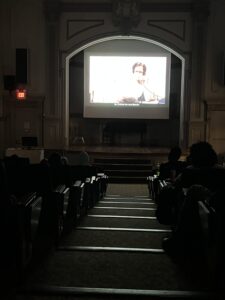After a run of B-movie horrors this October, the Young building auditorium will welcome back audiences for film noir series Noir-vember. Hosted by the Camosun College Student Society (CCSS), the November-long event will include four free-admission screenings, The Strange Love of Martha Ivers (1946, screening on November 7), Kansas City Confidential (1952, screening on November 14), The Hitch-Hiker (1953, screening on November 21), and Too Late For Tears (1949, screening on November 28).
Organized by CCSS clubs and events assistant Amy Lee-Radigan, the series offers students a look back into film history, but Lee-Radigan says the films can be appreciated by even modern film lovers.

“There are so many movies that come out in current times that are based on the noir genre,” says Lee-Radigan, “and it’s so often parodied that watching the originals can give you a huge amount of context for seeing the ones that are quite modern. And they’re so much fun. They’re very moody; the writing is often incredibly good.”
While students often have limited time and resources to find and support community in the midst of the semester, Lee-Radigan says Noir-vember gives students an opportunity to connect.
“Same thing that the other movie nights offer,” they say. “It’s just a lot of community, a way to unwind from classes, a nice way to get out to the movies that is also free.”
The classic period of film noir was during the 1940s and 1950s, when motion pictures were generally filmed in black and white. Lee-Radigan says that while some younger audiences may not be accustomed to the format, there are many characteristics of film that can only be enjoyed through the genre.
“Noir is so good at using that black and white film to its advantage,” they say. “All of the films are very much shot with black and white in mind, and so they make use of these shadows, and they do a lot of really interesting cinematography elements. If you don’t like black and white films, you might like noir films because they’re not just happened to be filmed in black and white, they are elevated because they’re in black and white.”
Lee-Radigan says they first developed an interest for film noir when writing a paper for a Camosun class, which prompted them to explore more films of the period. They say they were surprised by the genre.
“I found them so much better written than I thought they would be,” they say. “I think it’s also [that] justice is such a through-plot and not necessarily specifically rooted in a… It’s in a very ‘shades of grey’ way. There’s a lot of anti-heros in it, there’s a lot of the falsely accused criminals that have to prove their innocence. You get a lot of that. There’s very little… Despite being all in black and white, there’s very little emotional black and white in film noir.”
This is the last film series currently planned by the CCSS, but Lee-Radigan says the student society encourages student suggestions and hopes to continue the tradition (see camosunstudent.org for more info about the student society).
“If students want to approach us with ideas, if they’re older genres, that’s great because we try to use all public-domain movies. But if there are specific genres from, usually, ’40s, ’50s, ’60s are pretty safe range… Film noir was partially because I personally was interested in it, but also largely because that’s a genre that falls really neatly in that public domain range right now… but if other students want to come to us with ideas, that would be fantastic. I would love that.”
